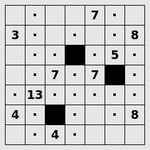Range is one of the puzzles in Simon Tatham's Portable Puzzle Collection. It is described there as:
"Place black squares to limit the visible distance from each numbered cell."
It is played on a grid that starts empty aside from a handful of numbers. Those numbers represent the total blank squares "visible" in each of the 4 cardinal directions prior to hitting a blocked square. The goal of the game is to identify where the blocked squares lie. There are two additional rules. All the unblocked squares must be connected. And no two blocked squares can be adjacent.
We're going to work with patterns where a pattern is cross shaped set of squares showing how the empty and blocked squares might be laid out relative to one particular number. The end square of each arm in a given pattern has a blocked square and the rest of the squares in the pattern are empty. First we will generate all the possible patterns for each number square, then we will successively eliminate possible patterns via constraint propagation until we are left with only the actual patterns and by extension the actual blocked squares. Isn't this inefficient? I hear you ask. Just how many patterns are there for each number? you ask. If you take the 4 arms of the patterns cross, chop of the blocked squares and lay the empty squares end to end you get a strip of N-1 length (where N is the patterns number) with 3 cut points. So the question of how many patterns there are can be reduced to how many cut points which is given by (N(N+1)(N+2))/6, the largest number is 15 which has 680 patterns, no biggie.
We'll need a simple clear text input and output format.
..for unknown01for a small number12for a bigger numberXXfor definitely blocked So the game state in the image above would be:
.. ....07 ..
03 .. .. 08
.. XX 05
.. 07 07XX
13
04 XX .. 08
.. 04 ......
We could chop the arms of the patterns to the size of the grid as we generate them, but that's a hassle, so instead we will make the arms complete and then inject blocked squares around the perimeter eliminating any arms that cross the edge. With that in mind generating the patterns is trivial. We will store them as little objects that have the number square they belong to, which squares they require to be blocked, which squares empty and an eliminated flag. For each square we will also keep lists of the patterns that require that square to be blocked and the patterns that require it to be empty.
As mentioned above we need the whole border to be outlined with blocked. We also need the number squares to be marked empty. Whenever we inject data we eliminate all the patterns that conflict with the new data and queue their number squares to be updated.
For each queued number square we will look through all the squares in all of that number squares uneliminated patterns. Any square that is in all the patterns and has the same value in them all can be treated as known data and injected as above. While doing this we'll apply an additional rule that if we inject a blocked square we will also inject empty ones around it to prevent adjacent blocked squares. Since we set all the border squares to blocked above this needs to be clipped to the grid. And we proceed in this manner until the queue is empty.
The above covers all the game rules except the connectedness one. That's not easy to constraint propagate, so instead we will use a recursive search. Each time we exhaust the queue we copy the state, pick a random unknown square and mark it either blocked or empty and recurse. If we run out of unknown squares then we have a possible solution and we apply a spanning tree test to see if it meets the final rule. If it passes we win if not we keep searching. Additionally if during constraint propagation we end up with a number whose patterns have all been eliminated then we made a bad move and need to keep searching. To help this along we will keep blocked, empty and unknown lists in the state.
